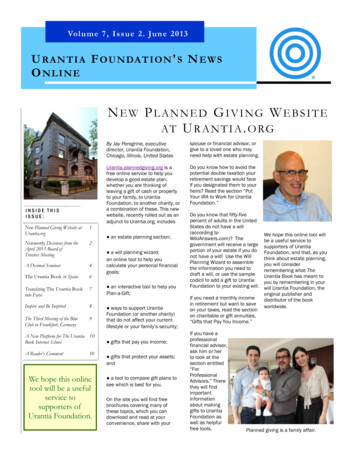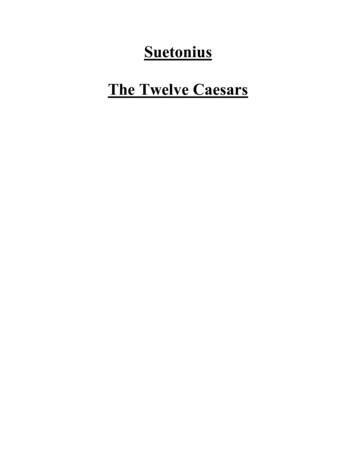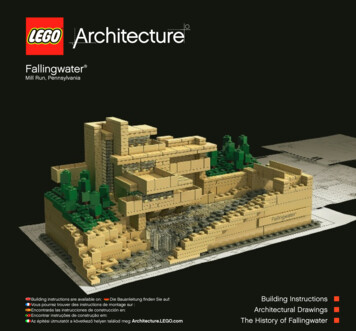
Transcription
Fallingwater Mill Run, PennsylvaniaBuilding instructions are available on:Die Bauanleitung finden Sie auf:Vous pourrez trouver des instructions de montage sur :Encontrarás las instrucciones de construcción en:Encontrar instruções de construção em:Az építési útmutatót a következő helyen találod meg: Architecture.LEGO.comBuilding InstructionsArchitectural DrawingsThe History of Fallingwater
Fallingwater2Courtesy of Western Pennsylvania Conservancy
ContentsFrank Lloyd Wright .5History of Fallingwater . 6Facts from the Project .8The Architect’s Thoughts about the Building . 9Building Instructions .11A Word from the Artist .104LEGO Architecture: Bringing two worlds together .105References . 1073
F.L. Wright Fdn.4
Frank Lloyd WrightPhoto: OBMA. F.L. Wright Fdn.Frank Lloyd Wright, 1867–1959, is recognized worldwide as one ofthe greatest architects of the 20th century. His work heralded anew approach to architecture using innovations in design andengineering made possible by newly developed technology andmaterials.No other American architect’s work endures, or remains ascompelling, as that of Frank Lloyd Wright. His was a unique stylerooted in nature, that he called “organic architecture,” emphasizingthe harmonious relationship between a building and itslandscape. It changed how we came to view our buildings, towns,and the land around us. F.L. Wright Fdn.5
History of Fallingwater “He had the design totally in his head, as always, andas he recommended to the apprentices, if no wholeidea, no architecture.” John Lautner, letter of June 20,1974. Lautner was an apprentice from 1933 to 1939.“Mr. Wright was not at all disturbed by the fact that notone line had been drawn. As was normal, he askedme to bring him the topographical map of Bear Runto his draughting table in the sloping-roofed studioat Taliesin, a rustic but wondrous room in itself.I stood by, on his right side, keeping his coloredpencils sharpened. Every line he drew, vertically andespecially horizontally, I watched with completefascination. Mr. Kaufmann arrived and Mr. Wrightgreeted him in his wondrously warm manner. In thestudio, Mr. Wright explained the sketches to his client.Mr. Kaufmann, a very intelligent but practicalgentleman, merely said. ‘I thought you would placethe house near the waterfall, not over it.’ Mr. Wrightsaid quietly, ‘E.J. I want you to live with the waterfall,not just to look at it, but for it to become an integralpart of your lives.’ And it did just that.” Bob Mosher,Letter of Jan. 20, 1974.“In 1963, Edgar Kaufmann Jr. gave his home, Fallingwater,to the Western Pennsylvania Conservancy with theintent that it be open to the public for tours. His giftconstitutes one of the most magnanimous acts in theannals of architectural and fine art history. This onebuilding, undoubtedly the most famous privateresidence built in a free, democratic society, has beenwidely published the world over since its completionin 1939, and its influence continues to this day.[1]”balconies above it, emphasizes this element ofprojecting forms merging building and landscape.In most architecture of the world, balconies are smallerfeatures of a larger, more stable mass. At Fallingwater,the entire house is composed of these projectionsfrom and above the rock ledges.The rooms themselves, with their adjacent outdoorterraces, are all a part of broad-sweeping balconiesreaching out to the branches of the surroundingtrees, and over the stream and waterfalls below.[2]”“Fallingwater is a country home, and in the annals ofso-called country homes it differs from any otherever built up to that time. Fallingwater achievessomething that no country home successfully hadbefore: it emphasizes, in every place and at everyturn, the wonder and beauty of nature in thiswoodland setting.[3]”“Fallingwater is that rare work which is composed ofsuch delicate balacing of forces and counterforces,transformed into spaces thrusting horizontally,vertically and diagonally, that the whole achieves theserenity which marks all great works of art.[4]”“The famous view of the house, taken from downstreamlooking up to the water cascades and under the F.L. Wright Fdn.6
F.L. Wright Fdn.Left: Elevation and Floor PlanAbove: Scaffolding7
Facts from the ProjectArchitect: .Frank Lloyd WrightClassification: . Vacation HomeYear: . 1935Construction Type: . Reinforced Poured Concretewith Limestone FasciaSquare Feet: .2,885 sq. ft. interiorOriginal Cost: . 155,000Top right: ScaffoldingBottom left: Construction workersBottom right: Construction8
The Architect’s Thoughts about the Building“The rock-ledges of a stone-quarry are a story and alonging to me. There is suggestion in the strata andcharacter in the formations.I like to sit and feel it, as it is. Often I have thought,were great monumental buildings ever given me tobuild, I would go to the Grand Canyon of Arizona toponder them For in the stony bone-work of theEarth, the principles that shaped stone as it lies, or asit rises and remains to be sculptured by winds andtide – there sleep forms and styles enough for all theages for all of Man.[5]”“The visit to the waterfall in the woods stays with meand a domicile has taken vague shape in my mind tothe music of the stream. When contours come youwill see it. Meantime, to you my affection. [6]”“This structure might serve to indicate that the senseof shelter has no limitations as to form except thematerials used and the methods by which they areemployed for what purpose.[7]”“Looking back years later at what he had createdthere, in this enchanted glen, Wright said, ‘Fallingwateris a great blessing – one of the great blessings to beexperienced here on earth. I think that nothingyet ever equaled the coordination, sympatheticexpression of the great principle of repose, whereforest and stream and rock and all the elements ofstructure are combined so quietly that really youlisten not to any noise whatsoever, although the musicof the stream is there. But you listen to Fallingwaterthe way you listen to the quiet of the country.’[8]” Hedrich-BlessingAbove: Desk and viewLeft: Living Room Yukio Futagawa9
Side elevationFront elevationAdam Reed TuckerArchitectural LEGO ArtistPlanview
Building Instructions11
2x1121x2x3x
1x1x2x1x3x8x2“Bring out the nature of the materials, lettheir nature intimately into your scheme. Reveal the nature of the wood, plaster,brick or stone in your designs, they areall by nature friendly and beautiful.”– Frank Lloyd Wright, 190813
1x1x3142x1x1x1x
1x2x2x1x6x415
1x5162x1x1x
5x2x1x8x617
4x1x7181x2x
4x1x5x1x13241x8519
6x93x20
1x2x1x1x1x1021
1x1x1x11224x1x1x
1x1x2x2x1x1x1223
1x2x1x1x1x3x1324
3x1x1x1x3x1x1x1x9x14“By organic architecture I mean anarchitecture that develops from withinoutward in harmony with the conditionsof its being, as distinguished from onethat is applied from without.”– Frank Lloyd Wright, 191425
1x15261x3x13x
1x3x1x4x1x2x1627
3x3x3x1x4x5x17123x28
1x1x1x1x1x1829
3x1x1x2x3x1x1x1913023
1x1x1x4x1x1x20“Architecture is the triumphof Human imagination overmaterials, methods, and mento put man into possessionof his own Earth.”– Frank Lloyd Wright, 193031
5x3x1x1x213x321x2x1x
2x5x2233
1x23343x2x1x
1x3x5x1x2435
3x25361x1x
2x1x1x26“Architecture is the scientificart of making structure expressideas.”– Frank Lloyd Wright, 193037
2x1x4x2x1x1x1x1x1x1x1x27381x1x
1x1x1x5x2839
9x29402x1x1x1x
5x2x1x2x2x2x3x3041
4x31421x4x1x3x3x3x
3x1x4x1x2x32“Stone is inflorescent: stone is the massresidue of intense heat. Stone is thereforethe simplest mass material. As humanhands directed by the imagination beginupon it, it becomes a shapely block.”– Frank Lloyd Wright, 193743
6x33442x1x
1228x3414x45
1x21x1462x
1x1x1x31x447
1x1x1x1x51248
2x1x62x1x1x1x1x1x7“Architecture is that great living creative spiritwhich from generation to generation, from ageto age, proceeds, persists, creates, accordingto the nature of man, and his circumstances asthey both change. That really is architecture.”– Frank Lloyd Wright, 193949
1x1x2x1x81250
1x1x1x1x91251
1x1x10521x2x2x2x1x2x1x1x1x1x1x1x1x142536
53
1x1x2x4x1x1x4x4x1154
4x1x1x1x2x1x12“I had an idea that the horizontal planesin buildings, those planes parallel to theearth, identify themselves with the ground– make the building belong to the ground.I began putting this idea to work.”– Frank Lloyd Wright, 194355
2x13563x3x1x1x
2x1x4x1x1x1x1457
2x15582x3x1x1x
2x1x3x1x1x1659
1x17601x2x1x2x1x
1x3x4x1812“In architecture, expressive changes ofsurface, emphasis of line & especiallytextures of material or imaginativepattern, may go to make facts moreeloquent – forms more significant.”– Frank Lloyd Wright, 194361
1x19623x1x1x
1x2x2x1x1x1x2063
2x21641x3x1x
1x2x3x1x2265
2x23661x3x1x
1x1x3x1x2x1x24“Organic architecture takes thisthought from within the nature of thething. It is a profound nature study.”– Frank Lloyd Wright, 195267
1x25682x2x1x
1x1x3x1x1x1x2669
1x27702x1x1x1x1x
1x4x2x1x2871
1x29722x1x
1x2x1x3073
1x31742x1x
1x1x2x1x3275
1x33761x1x
2x5x123477
3578
1x1x1x2x21x1x1“Rhythm in a building is largely a question of thethird dimension or the depth of the building. A thingis out of place when it is not in rhythm. And whatis rhythm in a building? In music you listen to it, inpainting you look at it, in a building you live with it.”– Frank Lloyd Wright, 195279
1x3801x1x41x1x
1x1x2x1x7x1x5681
1x7821x1x4x1x81x7x
2x91x7x1x3x7x10“I began to see a buildingprimarily not as cave but asbroad shelter in the open,related to vista; vista withoutvista within.”– Frank Lloyd Wright, 195483
1x1x1841x21x
1x32x1x1x485
1x5861x2x61x1x1x
1x71x1x1x1x1x2x1x1x887
2x9883x1x1x2x2x1x101x1x
5x1x111x2x2x13245x“A great architecture, a greatbuilding, must have a great concept. It must be born accordingto the depths of the humanmind and nature.”– Frank Lloyd Wright, 195589
1x12902x1x1x2x1x134x1x2x
14 “The cantilever is essentially steel at itsmost economical level of use. Constructionlightened by means of cantilevered steel intension, makes continuity a most valuablecharacteristic of architectural enlightenment.”– Frank Lloyd Wright, 195791
3x21x1921x
1x31x2x1x493
1x1x1x2x1x2x1x1x32x5941425
95
2x6962x1x1x2x73x1x2x
3x82x3x2x997
10 98
31x3x3x1x3x1142599
2 100
36101
37102
“Organic architecture sees the third dimensionnever as weight or mere thickness but alwaysas depth. Depth an element of space; the third(or thickness) dimension transformed to aspace dimension.”– Frank Lloyd Wright, 1957
A Word from the ArtistAs an Architectural Artist my desire is to capture theessence of a particular architectural landmark into itspure sculptural form. I first and foremost do not viewmy models as literal replicas, but rather my own artisticinterpretations through the use of LEGO bricks as amedium. The LEGO brick is not initially thought of asa material typically used in creating art or used as anartist’s medium. I quickly discovered the LEGO brickwas lending itself as naturally to my applications aspaint to a painter or metal to a blacksmith. As I explorehow to capture these buildings with the basic shapesof the bricks and plates, I find the possibilities andchallenges they offer almost magical.21005 FallingwaterThis model underwent a total of 14 design conceptsas it delicately incorporates a unique “pull-apart”interactive feature. Unlike the first 5 models in the LEGOArchitecture series which are static by design, I wantedto explore the use of the LEGO Brick even further byexpressing the dynamic nature of Fallingwater; withthis in mind I was able to have sections of the modelslide out. The design challenge was in figuring out howto cleverly disguise, in an almost puzzle-like designwhere the model comes apart without distorting one ofMr. Wright’s most recognizable achievements. Anotherdesign concern was how to carefully balance theplayful nature of the river, waterfall, woods, and bridgethat embrace and define Fallingwater. These subtledetails give Fallingwater context, without which it wouldnot be possible to truly illustrate its beautiful, sensitiveand thoughtful design.Adam Reed TuckerArchitectural LEGO Artist104
LEGO Architecture: Bringing two worlds together The LEGO Group and Adam Reed Tucker are excited tobring you LEGO Architecture, a new line of LEGO buildingsets that celebrates world-renowned architects, whocontinue to inspire the builders of tomorrow. Whetheryoung and eager to learn or simply young at heartand intrigued by these modern day marvels, we hopethe Architecture series inspires builders of all ages bycelebrating the past, present and future of architecturethrough the LEGO brick. Through incredible productsand exciting events, the Architecture series promotesawareness of the fascinating worlds of architecture,engineering and construction.Visit www.LEGO.com/architecture orwww.Brickstructures.com for more informationThe launch of the LEGO Architecture series beginswith a celebration of Frank Lloyd Wright, and one ofthe most famous buildings in the world, the Solomon R.Guggenheim Museum in New York City.We hope to inspire future architects around the world withthe LEGO brick as a medium. Enjoy this experience!105
42110612x424382420x41240671x4269651
he Architects Thoughts about the Building[5] Frank Lloyd Wright “In the Cause of Architecture: The Meaning ofMaterials – Stone.”Architectural Record, 63 (Apr. 1928), pp. 350, 356.[6] Frank Lloyd Wright, “In the Cause of Architecture: The Meaning ofMaterials – Stone.”Architectural Record, 63 (Apr. 1928), pp. 350, 356.[7] Frank Lloyd Wright, “Architectural Forum.” 1938[8] Frank Lloyd Wright, 1955 FLLW Tape Transcript No. 129, part 2, p. 11Bruce Brooks Pfeiffer, “Frank Lloyd Wright - Fallingwater.” 2003, Pg. 20.38x424556614x421152514x42165814x4211001The History of Fallingwater[1] Bruce Brooks Pfeiffer, “Frank Lloyd Wright - Fallingwater,” 2003, Pg. 6[2] Bruce Brooks Pfeiffer, “Frank Lloyd Wright - Fallingwater,” 2003, Pg. 10[3] Bruce Brooks Pfeiffer, “Frank Lloyd Wright - Fallingwater,” 2003, Pg. 20[4] Paul M. Rudolph, 1970, “Global Architecture – Frank Lloyd WrightKaufmann House, “Fallingwater,” Opening Paragraph.For further information please visit:www.franklloydwright.orgThe publicity rights to the name and likenessof Frank Lloyd Wright belong to the FrankLloyd Wright Foundation, Taliesin West,Scottsdale, Arizona. Frank Lloyd Wright, theFrank Lloyd Wright signature, the Frank LloydWright Collection logo, and the authorizedproduct logo (rectangular logo box) areregistered trademarks of the Frank LloydWright Foundation. The drawings and designsof Frank Lloyd Wright are copyright theFrank Lloyd Wright Foundation.Customer ServiceKundenserviceService ConsommateursServicio Al Consumidorwww.lego.com/service or dial00800 5346 5555 :1-800-422-5346 :107
This product is authorized by theFrank Lloyd Wright Foundation,Taliesin West, Scottsdale, Arizona.108 and the LEGO logo are trademarks of the LEGO Group. 2011 The LEGO Group. 4644799LEGO
new approach to architecture using innovations in design and engineering made possible by newly developed technology and materials. No other American architect’s work endures, or remains as compelling, as that of Frank Lloyd Wright. His was a unique style rooted in nature, that he called

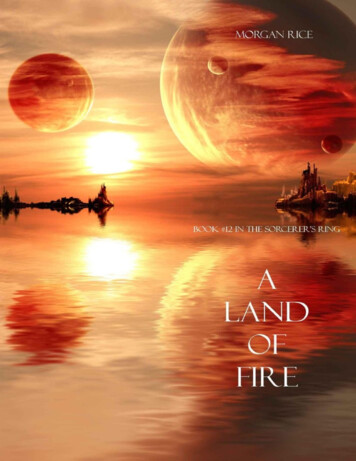



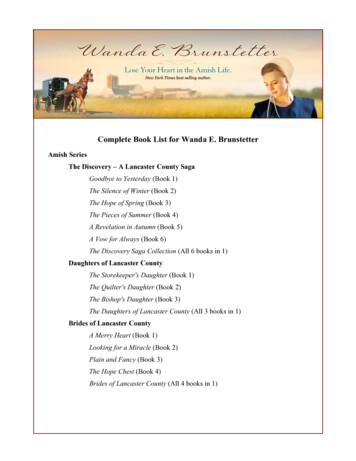
![The Book of the Damned, by Charles Fort, [1919], at sacred .](/img/24/book-of-the-damned.jpg)

